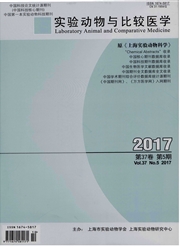

 中文摘要:
中文摘要:
目的 观察不同剂量60Coγ射线照射比格犬后外周血象的变化,为小剂量辐射防护新药评价建立动物模型.方法 雄性比格犬24只分为5组:0.3 Gy连续5d屏蔽组,0.6 Gy连续3d屏蔽组和连续5d屏蔽组,1Gy1次照射屏蔽组,不屏蔽组1.1 Gy,连续观察30 d.临床指标有体温、体质量、临床症状等;分别在照前和照后不同时间检测外周血象.结果 0.6 Gy连续5d照射组动物存活率为33%,其余各组均全部存活.0.6 Gy连续3d照射白细胞和血小板均在1~23 d明显降低,0.6 Gy连续5d照射白细胞和血小板均在1~25 d明显降低,1.0 Gy照射白细胞在7~21 d明显降低、血小板在11~17d明显降低.0.6 Gy连续3d照射红细胞在照后5~15 d、血红蛋白在5d明显降低;0.6 Gy连续5d照射红细胞在照后13~25 d明显降低.0.6 Gy连续5d照射血红蛋白在照后13~25 d明显降低.结论 综合存活率、临床症状、外周血指标变化等,0.6 Gy连续3d照射可作为小剂量辐射防护药物的药效学评价模型.
 英文摘要:
英文摘要:
Objective To study the changes of peripheral blood cells of irradiated Beagle dogs, in order to set up low dose radiation-injured dog model for evaluating new drug. Methods Twenty-four male Beagle dogs were divided into five groups, 1.1 Gy irradiated was the control group, and the rest four groups dog were shielding irradiated using lead plate, which invovled in 0.3 Gy continuous five days, 0.6 Gy continuous three or five days, and 1.0 Gy. Blood samples were collected and the numbers of peripheral blood cells were counted using a microcell counter. Clinical index such as body temperature, body weight, and clinical symptoms were observed. Results The survival rate was 33% in group of 0.6 Gy irradiation for continuous five days, and the rest dogs from other groups were all survived. The number of white blood cells and platelets decreased from first to twenty-third day in dogs from group of 0.6 Gy irradiation for continuous three days, and decreased from first to twenty-fifth day in dogs from group of 0.6 Gy irradiation for continuous five days. The number of white blood cells decreased from seventh to twenty-first day in dogs from group of 1.0 Gy irradiation, and platelets decreased from eleventh to seventeenth day. The number of red blood cells decreased from fifth to fiftenth day in dogs from group of 0.6 Gy irradiation for continuous three days and hemoglobins decreased on fifth day. Red blood cells decreased from thirteenth to twenty fifth day in group of 0.6 Gy irradiation for continuous five days and hemoglobins decreased from thirteenth to twenty fifth day. Conclusion Based on survival rate, clinical symptoms and peripheral blood cells, the group of 0.6 Gy irradiation for continuous three days was chosen as low dose radiation-injured dog model to evaluate new drug.
 同期刊论文项目
同期刊论文项目
 同项目期刊论文
同项目期刊论文
 期刊信息
期刊信息
